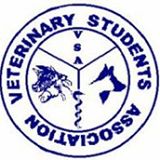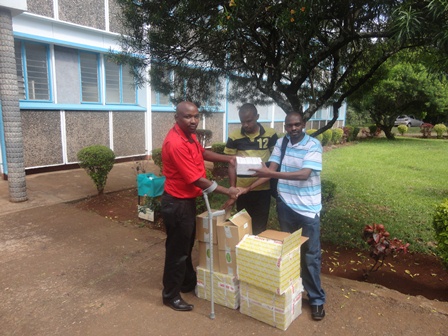INTRODUCTION
This report covers a student field visit to Kapiti Plains ranch on 25th October 2013. This was carried out under herd health field experiences. Herd health serves to enhance practical experience for the students in the final (Fifth) year of Bachelor of Veterinary Medicine (BVM) on management practices in dairy, beef, small ruminants and porcine production in addition to participating in corporate social responsibility activity to assist needy communities.
The visit to Kapiti ranch provided a field experience for over fifty undergraduate students. Three (3) members of teaching staff and two (2) drivers participated in the activity. Students had an opportunity to interact with staff at Kapiti ranch and learn more on beef and mutton production in addition to the dynamics and challenges involved in these practices under range land management. The challenges of wildlife-cattle interaction were also addressed. The trip was a success owing to the contribution and participation of all.
History of the Ranch.
The university group was welcomed to the ranch by the farm manager and a brief introduction was done. The farm manger then gave a brief history of the ranch and the main activities that were to be carried out during the day. The group was informed that the ranch was owned by International Livestock Research Institute (ILRI) and was acquired in 1983 with the aim of conducting livestock based research especially in tropical animal diseases. However over the years the ranch had been commercialised due to economic constrains and reduction in donors funding. The farm manager also informed the group that the ranch covered 33, 000 hectares of land, had 2,500 heads of cattle, 1,000 flock of sheep and provided employment to 60 people at the time. After the introduction, the group departed to the ranch to see the main activities carried out in the farm as planned by the farm manager.
Activity 1: Spraying
Cattle’s dipping was the first activity of the day. Students had an opportunity to experience how a spray race can be an effective and an efficient way of ectorapasite control in a large number of cattle. As spraying was going on, the group was informed that tick borne diseases were a major challenge that hampered production at the ranch and which resulted into massive losses due to mortalities, reduced growth rate and the cost of treatment. Owing to this challenge, the manager informed the group that they observe very strict tick control measures which involve spraying the animals weekly on Fridays during dry season and after every three days during the wet season. In addition the group also learnt how to constitute the pesticides to avoid overdosing which would result into toxicity or under dosing which would result into tick’s resistance to the pesticides. The structures used to restraint animals and the machines used in spray race were also noted.
Activity 2- The N’Dama breed
The second activity of the day was to see the N’Dama breed of the cow. The group was taken to the grazing field to see the N’Dama which is a breed of the cow originally from West Africa and that is resistance to trypanosomiasis. The manager informed the group that the ranch had 500 N’Dama cattle and that they were inter breeding the animals with Boran and Friesian breeds to reduce the susceptibility of indigenous cattle to trypanosomiasis and at the same time maintain a reasonable level of production.
Activity 3- Ranch Management
After an enjoyable drive to the vast kapiti ranch, the group had a short break and during this break, the ranch manager took the opportunity to educate the group about the management practices carried out in the farm and the main challenges that the ranch was facing. The manager informed the group that immediately the calves are born, birth weight is taken and animal identification is done within one week. Identification methods used includes branding, ear notching and tattooing. Calves are left to suck ad libitum, dehorning done at one week while castration (for male calves) and weaning is done at 8 months of age. During weaning, both the calves and the dam are weighed as this is a good indicator of mothering ability. Usually the target is to wean calves that weight half the weight of the dam. Mothering ability is one of the important characteristic that is considered when making a decision on which animal to cull and retain for breeding.
After weaning the calf, the steers are selected and fattened for sale while the heifers are selected for replacement of the breeding stock. The manager also informed the group that culling is done based on age, mothering ability, the physical characteristics and reproduction qualities like calving intervals. Vaccination against foot and mouth disease (FMD) are done in April, August and December; vaccination against black quarter and anthrax is done in June while vaccination against rift valley fever (RVF) and lumpy skin disease (LSD) are done during outbreaks or as advised by the Director of Veterinary Services.
The group learnt that the main challenge facing beef production in Kapiti ranch was competition for pasture with other wild herbivore especially zebras and wildebeasts, wildlife-cattle shared diseases notably malignant catarrhal fever (MCF) and drought. However, despite all these challenges the manager noted that there were still many opportunity that could be exploited in the ranch notably tourism and dairy ranching.
Activity 4- Sheep Project
The group visited the sheep project that had 1000 sheep under semi-intensive production system. Usually the sheep are grazed in mobile paddocks and in the evening housed in bomas where minerals and supplement are provided. Identification is done by ear tagging while for breeding purposes the group learnt that sheep are usually bred only once per year during the wet season. Vaccination is done against pulpy kidney at 4, 6 and 9 month of age while booster vaccination is administered to pregnant ewes prior to lambing. The group was also informed that the main challenge facing sheep was helminthosis. However, the opportunities for sheep ranching were expanding due to increasing demand for mutton compared to beef.
Activity 5- Visit to the Dam
The group had an opportunity to visit one of the three dams within the ranch that is used by both the cattle and the wild animal. During the visit to the dam, wilderbeast, antelopes, zebras, warthog amongst other wild animals were seen.
Activity 6- Visit to the Embryo Transfer Facility
The last activity of the day was to visit a research facility within the ranch that is used mainly for embryo transfer. Although there was no research activity going on during the visit, the group had an opportunity to see the structure used to restrain the animals, the machines and laboratory equipment used to facilitate effective collection, storage and transfer of embryos in cattle.
CONCLUSION AND ACKNOWLEDGEMENTS
The event went a long way in exposing student to management practices in beef and mutton production as well as the challenges and opportunities that are available in both production systems. The opportunity for research in tropical animal diseases especially those shared by wildlife and cattle was also noted. Linkages were built with Kapiti ranch and international livestock research institute (ILRI).
The trip was incident free and met the desired goals. It is therefore recommended that such activities be intensified for the final year students taking BVM in order to improve the quality of the graduates joining the job market.
We wish to express our gratitude to, the farm manager Kapiti ranch, the principal CAVS, Chairman CSD, Herd health coordinator for the support and encouragement towards this exercise.

